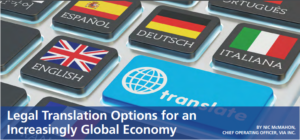As a growing number of businesses expand their market reach to compete in the global economy, the need for legal transactions that span multiple languages, cultures and legal systems has become greater than ever. Now, in addition to the multitude of competing demands already placed on legal and compliance professionals, they must also determine how best to handle these complex and challenging communication requirements.
Every legal matter is unique. Some are best suited for high-volume machine translation while others require individually translated content by in-region legal linguists. The best translation service providers offer customized litigation translation options and recommendations tailored to specific client needs.
Yet choosing one of a multitude of available language translation options can still seem daunting. What types of translation services are available? When is machine translation a viable option? And when do you need an attestation or certified document translation?
What Is Translation?
Translation is defined as the process of transmitting content from one language into another. For most organizations seeking translation services, translation involves adapting a document or other text-based media (app, website, etc.) from an original language into a target language, using the grammar and vocabulary of the target language to best convey the meaning of the original document.
Translation is often performed by some combination of human linguists and Machine Translation (MT) to ensure the most accuracy, and the work is always checked by editors.
It is worth noting that although translation has a lot in common with interpreting, they are also not the same. While translation is written, interpreting is verbal and usually involves an interpreter bridging the gap between two or more people who speak different languages.
Interpreting services are usually conducted in the same room, over the phone, or over video conferencing to help with real-time, in-person communication.
What Is Localization?
Localization goes one step beyond translation and is defined as the process of adapting content more holistically for a new linguistic and cultural audience.
While translation might be more general -- an English to Spanish translation could be appropriate for an audience in Spain, Peru, or Mexico, for example -- localized content would be more specific for these three different regions and take their culture as well as their language into consideration.
In addition to changing the language, localization might incorporate different images, conversions to new measurement systems, time zones or currencies, and different layouts to accommodate language quirks (for example, if a language is read right to left, or if words in the target language tend to be longer than in the original language).
To use our Spain-Peru-Mexico example, a global e-commerce website trying to appeal to audiences here should include localized images that represent the population of each of these countries and should also update the currencies accordingly (euro for Spain, sol for Peru, peso for Mexico).
In short, translation is a word-for-word adaptation; localization goes one step further to account for cultural differences on top of translation.
Google+ Facebook LinkedIn Twitter Instagram
How Translation And Localization Work Together
With translation and localization, one is rarely used without the other. Substituting word for word with a translation dictionary, linguist, or MT might lead to technical proficiency, but it is often lacking the nuances or “spirit” of a text and how it is perceived by the target audience.
While translation may play a larger role by itself in simpler situations such as adapting a legal document or technical form, localization is particularly important with marketing campaigns or other communications that are meant to appeal to emotion or spur action as well as provide information.
Websites and other interactive online media rely extensively on both translation and localization to reach the broadest audiences, balancing the need for widespread appeal with the customized content that different regional and cultural groups might respond to best.
Project scopes and complexity vary and require different amounts of translation and localization. Working with an established Language Solutions Provider (LSP) can help you determine the best course of action for translating and localizing your content, while staying “on brand” and ensuring as much continuity as possible.

